Risk Assessment and Project Management in Equipment Procurement
VerifiedAdded on 2023/06/10
|18
|5273
|330
Report
AI Summary
This report delves into the project management aspects of procuring patient lift equipment for Smyth Lodge care home in the UK, focusing on risk assessment and mitigation strategies. It identifies the project as a procurement-based manufacturing initiative aimed at improving patient transfer within the facility. The report outlines the project lifecycle, from initiation to closure, emphasizing the importance of time, cost, and scope management. Methodologies like Waterfall and Agile are discussed, with a preference for Agile to accommodate flexibility. Key deliverables, including contracts, project schedules, and spending records, are highlighted. The risk assessment stages are detailed, focusing on hazard identification and risk mitigation techniques such as exploitation and sharing. Furthermore, the report addresses the composition and management of the project team to ensure successful implementation, considering roles, responsibilities, and communication strategies.
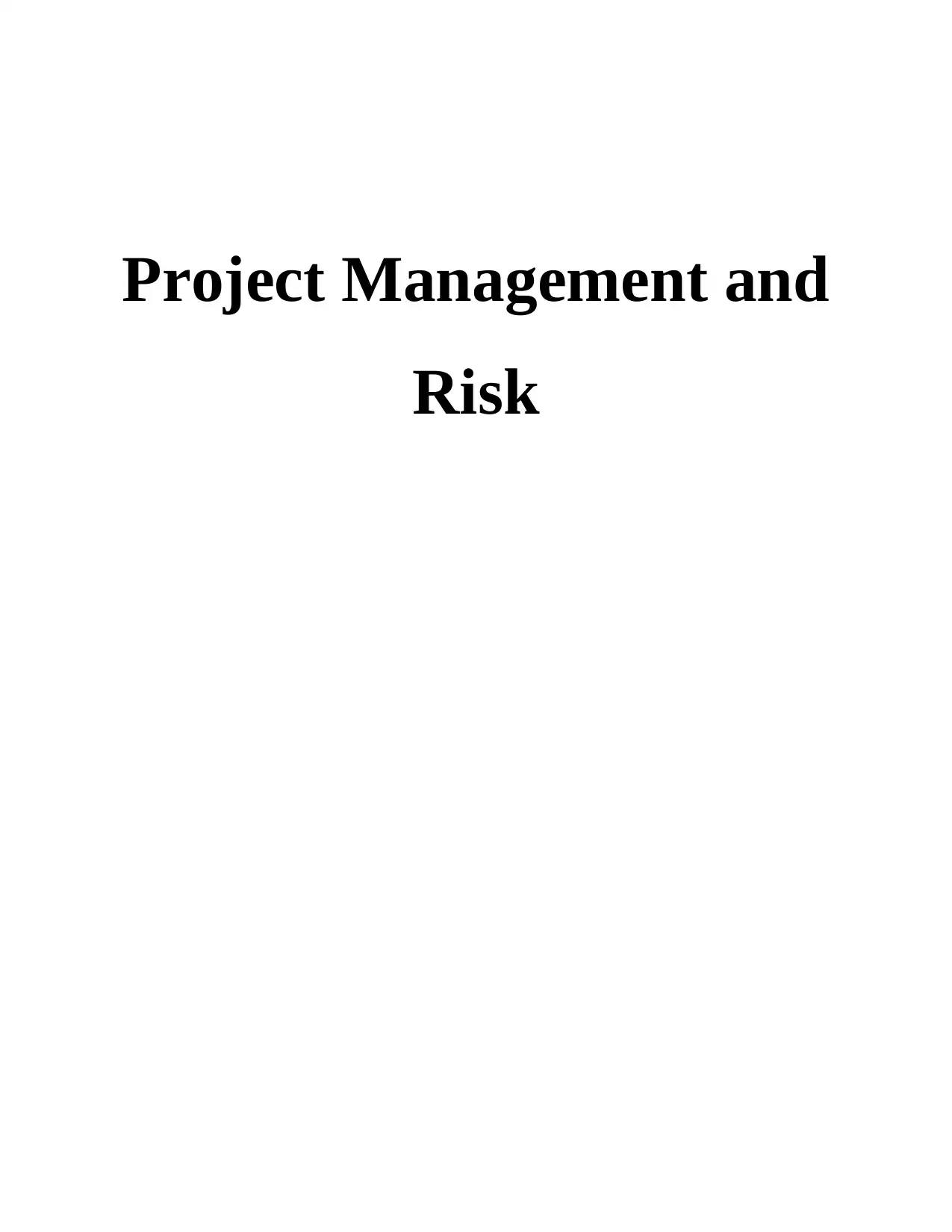
Project Management and
Risk
Risk
Paraphrase This Document
Need a fresh take? Get an instant paraphrase of this document with our AI Paraphraser

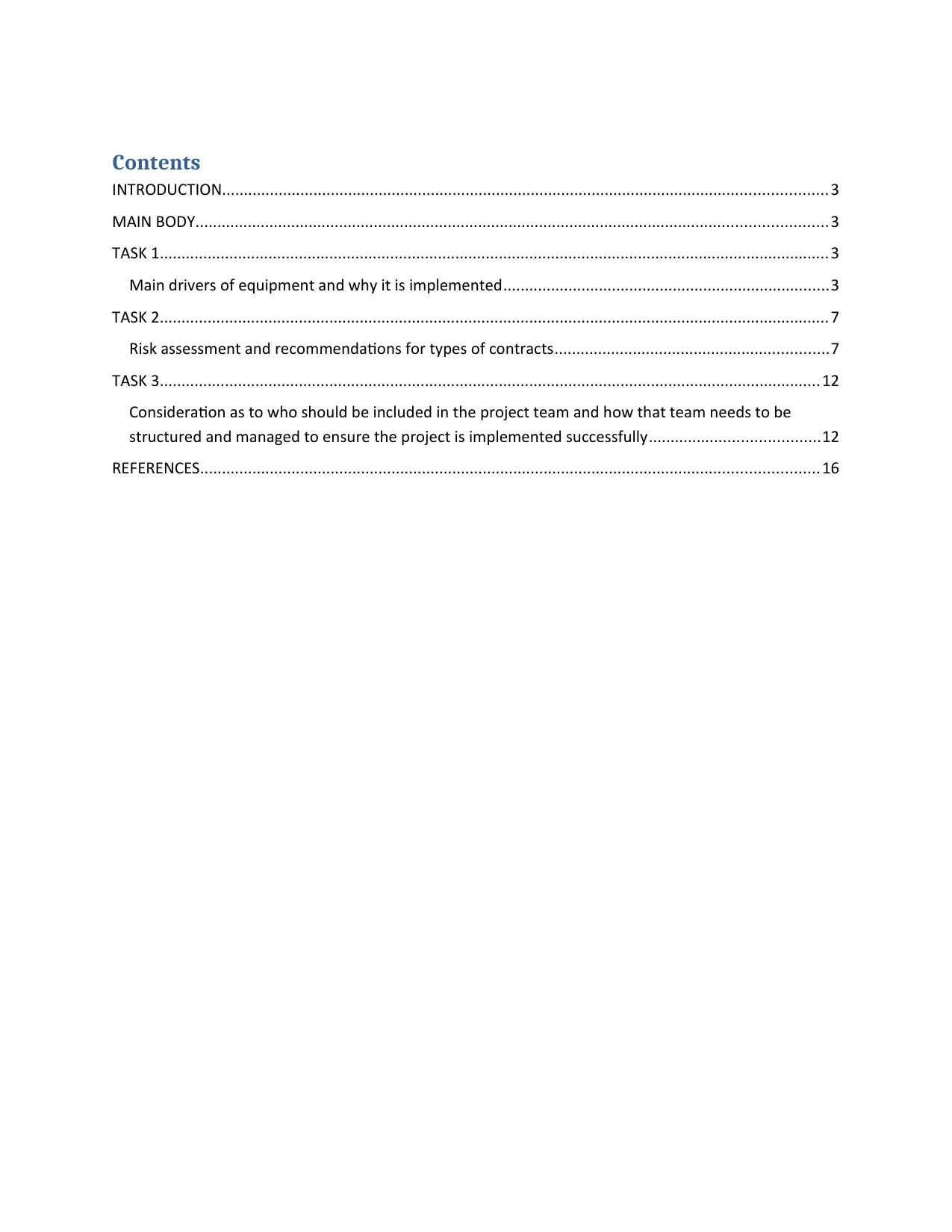
Contents
INTRODUCTION...........................................................................................................................................3
MAIN BODY.................................................................................................................................................3
TASK 1..........................................................................................................................................................3
Main drivers of equipment and why it is implemented...........................................................................3
TASK 2..........................................................................................................................................................7
Risk assessment and recommendations for types of contracts...............................................................7
TASK 3........................................................................................................................................................12
Consideration as to who should be included in the project team and how that team needs to be
structured and managed to ensure the project is implemented successfully.......................................12
REFERENCES..............................................................................................................................................16
INTRODUCTION...........................................................................................................................................3
MAIN BODY.................................................................................................................................................3
TASK 1..........................................................................................................................................................3
Main drivers of equipment and why it is implemented...........................................................................3
TASK 2..........................................................................................................................................................7
Risk assessment and recommendations for types of contracts...............................................................7
TASK 3........................................................................................................................................................12
Consideration as to who should be included in the project team and how that team needs to be
structured and managed to ensure the project is implemented successfully.......................................12
REFERENCES..............................................................................................................................................16
⊘ This is a preview!⊘
Do you want full access?
Subscribe today to unlock all pages.

Trusted by 1+ million students worldwide
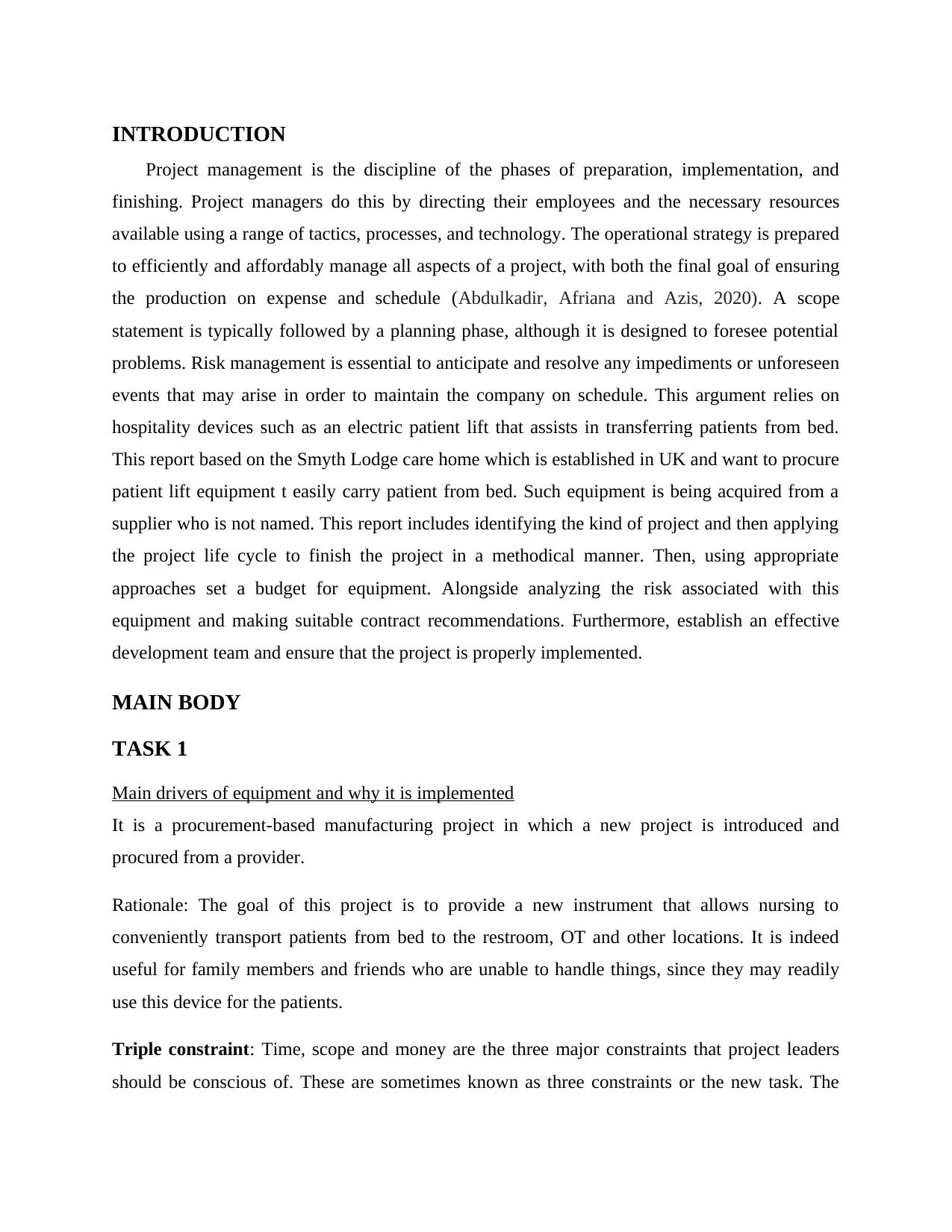
INTRODUCTION
Project management is the discipline of the phases of preparation, implementation, and
finishing. Project managers do this by directing their employees and the necessary resources
available using a range of tactics, processes, and technology. The operational strategy is prepared
to efficiently and affordably manage all aspects of a project, with both the final goal of ensuring
the production on expense and schedule (Abdulkadir, Afriana and Azis, 2020). A scope
statement is typically followed by a planning phase, although it is designed to foresee potential
problems. Risk management is essential to anticipate and resolve any impediments or unforeseen
events that may arise in order to maintain the company on schedule. This argument relies on
hospitality devices such as an electric patient lift that assists in transferring patients from bed.
This report based on the Smyth Lodge care home which is established in UK and want to procure
patient lift equipment t easily carry patient from bed. Such equipment is being acquired from a
supplier who is not named. This report includes identifying the kind of project and then applying
the project life cycle to finish the project in a methodical manner. Then, using appropriate
approaches set a budget for equipment. Alongside analyzing the risk associated with this
equipment and making suitable contract recommendations. Furthermore, establish an effective
development team and ensure that the project is properly implemented.
MAIN BODY
TASK 1
Main drivers of equipment and why it is implemented
It is a procurement-based manufacturing project in which a new project is introduced and
procured from a provider.
Rationale: The goal of this project is to provide a new instrument that allows nursing to
conveniently transport patients from bed to the restroom, OT and other locations. It is indeed
useful for family members and friends who are unable to handle things, since they may readily
use this device for the patients.
Triple constraint: Time, scope and money are the three major constraints that project leaders
should be conscious of. These are sometimes known as three constraints or the new task. The
Project management is the discipline of the phases of preparation, implementation, and
finishing. Project managers do this by directing their employees and the necessary resources
available using a range of tactics, processes, and technology. The operational strategy is prepared
to efficiently and affordably manage all aspects of a project, with both the final goal of ensuring
the production on expense and schedule (Abdulkadir, Afriana and Azis, 2020). A scope
statement is typically followed by a planning phase, although it is designed to foresee potential
problems. Risk management is essential to anticipate and resolve any impediments or unforeseen
events that may arise in order to maintain the company on schedule. This argument relies on
hospitality devices such as an electric patient lift that assists in transferring patients from bed.
This report based on the Smyth Lodge care home which is established in UK and want to procure
patient lift equipment t easily carry patient from bed. Such equipment is being acquired from a
supplier who is not named. This report includes identifying the kind of project and then applying
the project life cycle to finish the project in a methodical manner. Then, using appropriate
approaches set a budget for equipment. Alongside analyzing the risk associated with this
equipment and making suitable contract recommendations. Furthermore, establish an effective
development team and ensure that the project is properly implemented.
MAIN BODY
TASK 1
Main drivers of equipment and why it is implemented
It is a procurement-based manufacturing project in which a new project is introduced and
procured from a provider.
Rationale: The goal of this project is to provide a new instrument that allows nursing to
conveniently transport patients from bed to the restroom, OT and other locations. It is indeed
useful for family members and friends who are unable to handle things, since they may readily
use this device for the patients.
Triple constraint: Time, scope and money are the three major constraints that project leaders
should be conscious of. These are sometimes known as three constraints or the new task. The
Paraphrase This Document
Need a fresh take? Get an instant paraphrase of this document with our AI Paraphraser
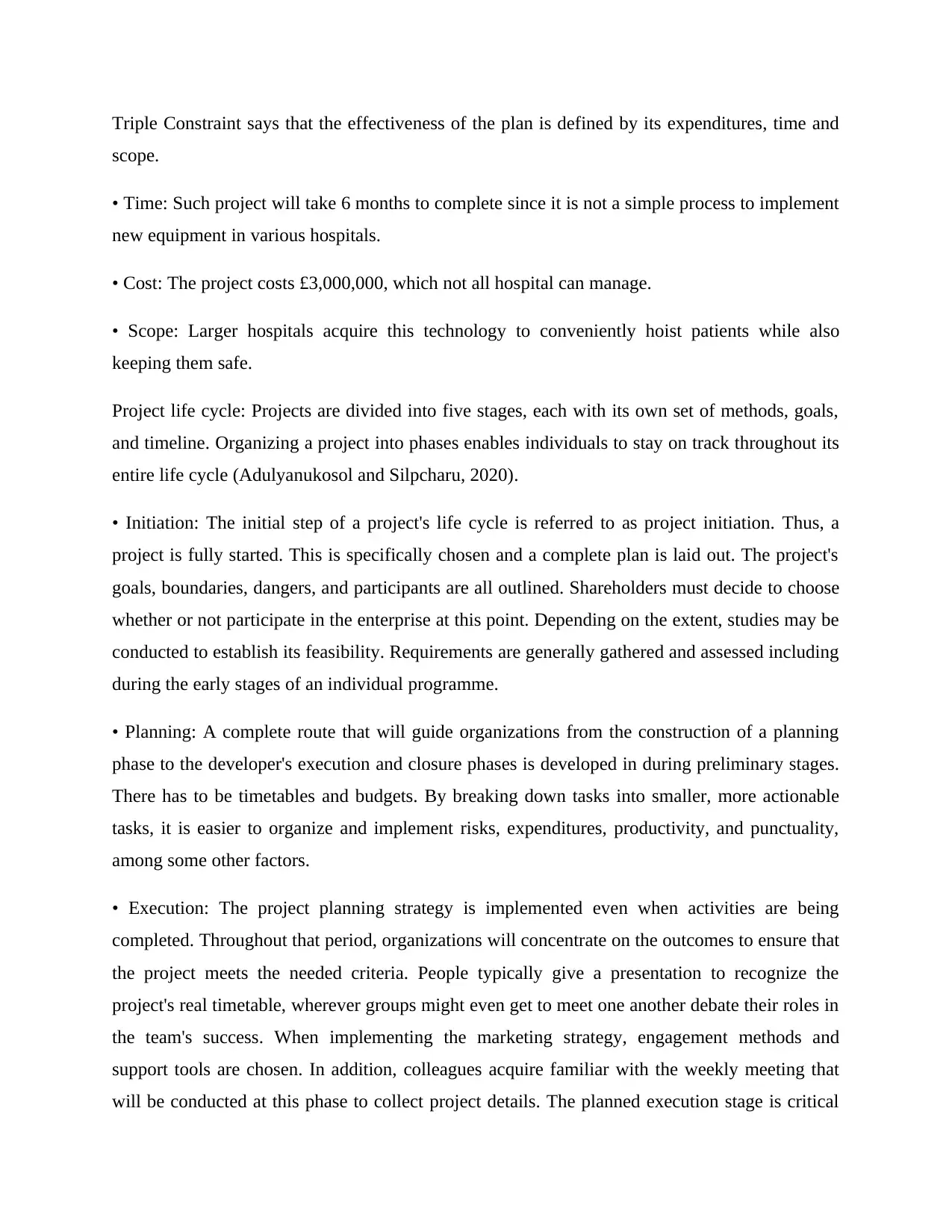
Triple Constraint says that the effectiveness of the plan is defined by its expenditures, time and
scope.
• Time: Such project will take 6 months to complete since it is not a simple process to implement
new equipment in various hospitals.
• Cost: The project costs £3,000,000, which not all hospital can manage.
• Scope: Larger hospitals acquire this technology to conveniently hoist patients while also
keeping them safe.
Project life cycle: Projects are divided into five stages, each with its own set of methods, goals,
and timeline. Organizing a project into phases enables individuals to stay on track throughout its
entire life cycle (Adulyanukosol and Silpcharu, 2020).
• Initiation: The initial step of a project's life cycle is referred to as project initiation. Thus, a
project is fully started. This is specifically chosen and a complete plan is laid out. The project's
goals, boundaries, dangers, and participants are all outlined. Shareholders must decide to choose
whether or not participate in the enterprise at this point. Depending on the extent, studies may be
conducted to establish its feasibility. Requirements are generally gathered and assessed including
during the early stages of an individual programme.
• Planning: A complete route that will guide organizations from the construction of a planning
phase to the developer's execution and closure phases is developed in during preliminary stages.
There has to be timetables and budgets. By breaking down tasks into smaller, more actionable
tasks, it is easier to organize and implement risks, expenditures, productivity, and punctuality,
among some other factors.
• Execution: The project planning strategy is implemented even when activities are being
completed. Throughout that period, organizations will concentrate on the outcomes to ensure that
the project meets the needed criteria. People typically give a presentation to recognize the
project's real timetable, wherever groups might even get to meet one another debate their roles in
the team's success. When implementing the marketing strategy, engagement methods and
support tools are chosen. In addition, colleagues acquire familiar with the weekly meeting that
will be conducted at this phase to collect project details. The planned execution stage is critical
scope.
• Time: Such project will take 6 months to complete since it is not a simple process to implement
new equipment in various hospitals.
• Cost: The project costs £3,000,000, which not all hospital can manage.
• Scope: Larger hospitals acquire this technology to conveniently hoist patients while also
keeping them safe.
Project life cycle: Projects are divided into five stages, each with its own set of methods, goals,
and timeline. Organizing a project into phases enables individuals to stay on track throughout its
entire life cycle (Adulyanukosol and Silpcharu, 2020).
• Initiation: The initial step of a project's life cycle is referred to as project initiation. Thus, a
project is fully started. This is specifically chosen and a complete plan is laid out. The project's
goals, boundaries, dangers, and participants are all outlined. Shareholders must decide to choose
whether or not participate in the enterprise at this point. Depending on the extent, studies may be
conducted to establish its feasibility. Requirements are generally gathered and assessed including
during the early stages of an individual programme.
• Planning: A complete route that will guide organizations from the construction of a planning
phase to the developer's execution and closure phases is developed in during preliminary stages.
There has to be timetables and budgets. By breaking down tasks into smaller, more actionable
tasks, it is easier to organize and implement risks, expenditures, productivity, and punctuality,
among some other factors.
• Execution: The project planning strategy is implemented even when activities are being
completed. Throughout that period, organizations will concentrate on the outcomes to ensure that
the project meets the needed criteria. People typically give a presentation to recognize the
project's real timetable, wherever groups might even get to meet one another debate their roles in
the team's success. When implementing the marketing strategy, engagement methods and
support tools are chosen. In addition, colleagues acquire familiar with the weekly meeting that
will be conducted at this phase to collect project details. The planned execution stage is critical
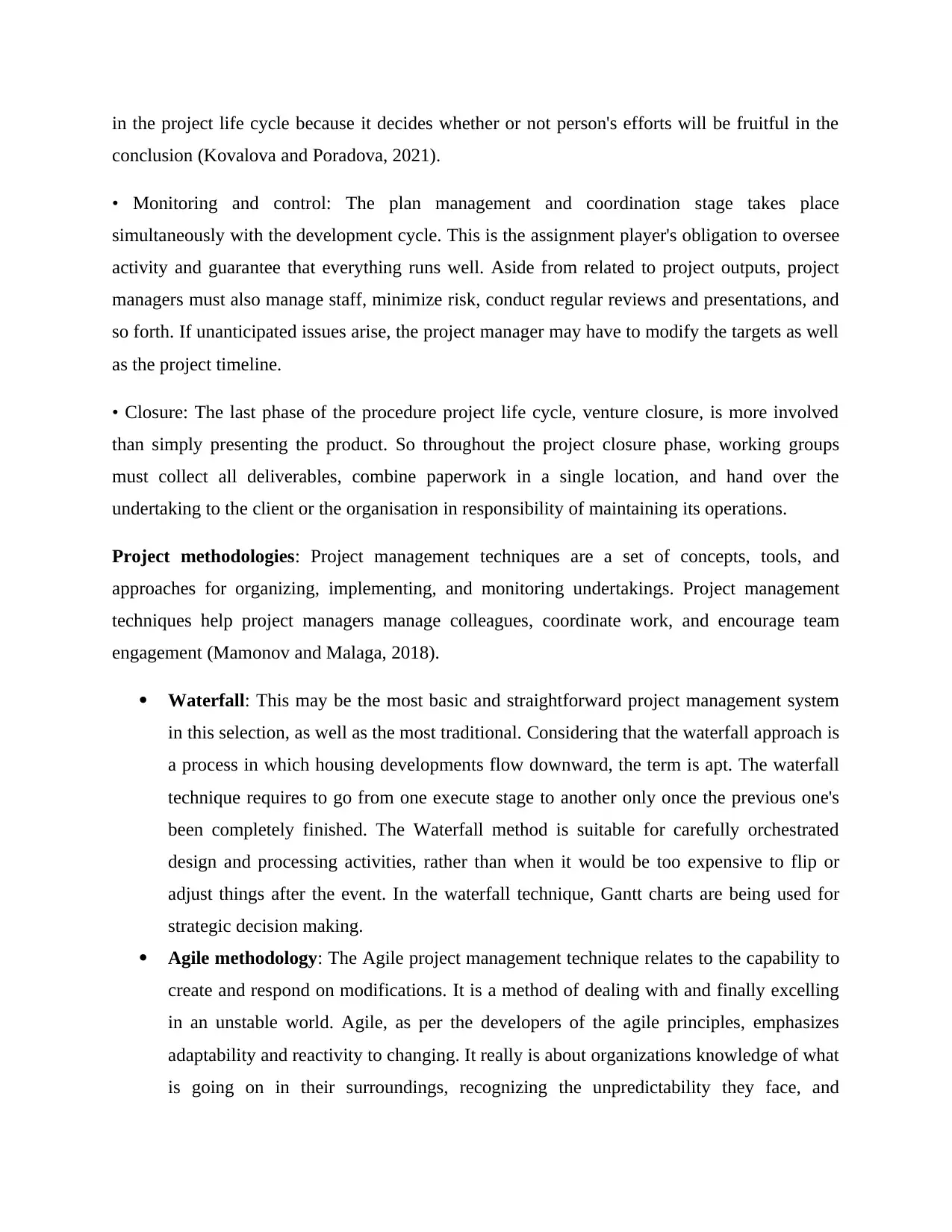
in the project life cycle because it decides whether or not person's efforts will be fruitful in the
conclusion (Kovalova and Poradova, 2021).
• Monitoring and control: The plan management and coordination stage takes place
simultaneously with the development cycle. This is the assignment player's obligation to oversee
activity and guarantee that everything runs well. Aside from related to project outputs, project
managers must also manage staff, minimize risk, conduct regular reviews and presentations, and
so forth. If unanticipated issues arise, the project manager may have to modify the targets as well
as the project timeline.
• Closure: The last phase of the procedure project life cycle, venture closure, is more involved
than simply presenting the product. So throughout the project closure phase, working groups
must collect all deliverables, combine paperwork in a single location, and hand over the
undertaking to the client or the organisation in responsibility of maintaining its operations.
Project methodologies: Project management techniques are a set of concepts, tools, and
approaches for organizing, implementing, and monitoring undertakings. Project management
techniques help project managers manage colleagues, coordinate work, and encourage team
engagement (Mamonov and Malaga, 2018).
Waterfall: This may be the most basic and straightforward project management system
in this selection, as well as the most traditional. Considering that the waterfall approach is
a process in which housing developments flow downward, the term is apt. The waterfall
technique requires to go from one execute stage to another only once the previous one's
been completely finished. The Waterfall method is suitable for carefully orchestrated
design and processing activities, rather than when it would be too expensive to flip or
adjust things after the event. In the waterfall technique, Gantt charts are being used for
strategic decision making.
Agile methodology: The Agile project management technique relates to the capability to
create and respond on modifications. It is a method of dealing with and finally excelling
in an unstable world. Agile, as per the developers of the agile principles, emphasizes
adaptability and reactivity to changing. It really is about organizations knowledge of what
is going on in their surroundings, recognizing the unpredictability they face, and
conclusion (Kovalova and Poradova, 2021).
• Monitoring and control: The plan management and coordination stage takes place
simultaneously with the development cycle. This is the assignment player's obligation to oversee
activity and guarantee that everything runs well. Aside from related to project outputs, project
managers must also manage staff, minimize risk, conduct regular reviews and presentations, and
so forth. If unanticipated issues arise, the project manager may have to modify the targets as well
as the project timeline.
• Closure: The last phase of the procedure project life cycle, venture closure, is more involved
than simply presenting the product. So throughout the project closure phase, working groups
must collect all deliverables, combine paperwork in a single location, and hand over the
undertaking to the client or the organisation in responsibility of maintaining its operations.
Project methodologies: Project management techniques are a set of concepts, tools, and
approaches for organizing, implementing, and monitoring undertakings. Project management
techniques help project managers manage colleagues, coordinate work, and encourage team
engagement (Mamonov and Malaga, 2018).
Waterfall: This may be the most basic and straightforward project management system
in this selection, as well as the most traditional. Considering that the waterfall approach is
a process in which housing developments flow downward, the term is apt. The waterfall
technique requires to go from one execute stage to another only once the previous one's
been completely finished. The Waterfall method is suitable for carefully orchestrated
design and processing activities, rather than when it would be too expensive to flip or
adjust things after the event. In the waterfall technique, Gantt charts are being used for
strategic decision making.
Agile methodology: The Agile project management technique relates to the capability to
create and respond on modifications. It is a method of dealing with and finally excelling
in an unstable world. Agile, as per the developers of the agile principles, emphasizes
adaptability and reactivity to changing. It really is about organizations knowledge of what
is going on in their surroundings, recognizing the unpredictability they face, and
⊘ This is a preview!⊘
Do you want full access?
Subscribe today to unlock all pages.

Trusted by 1+ million students worldwide
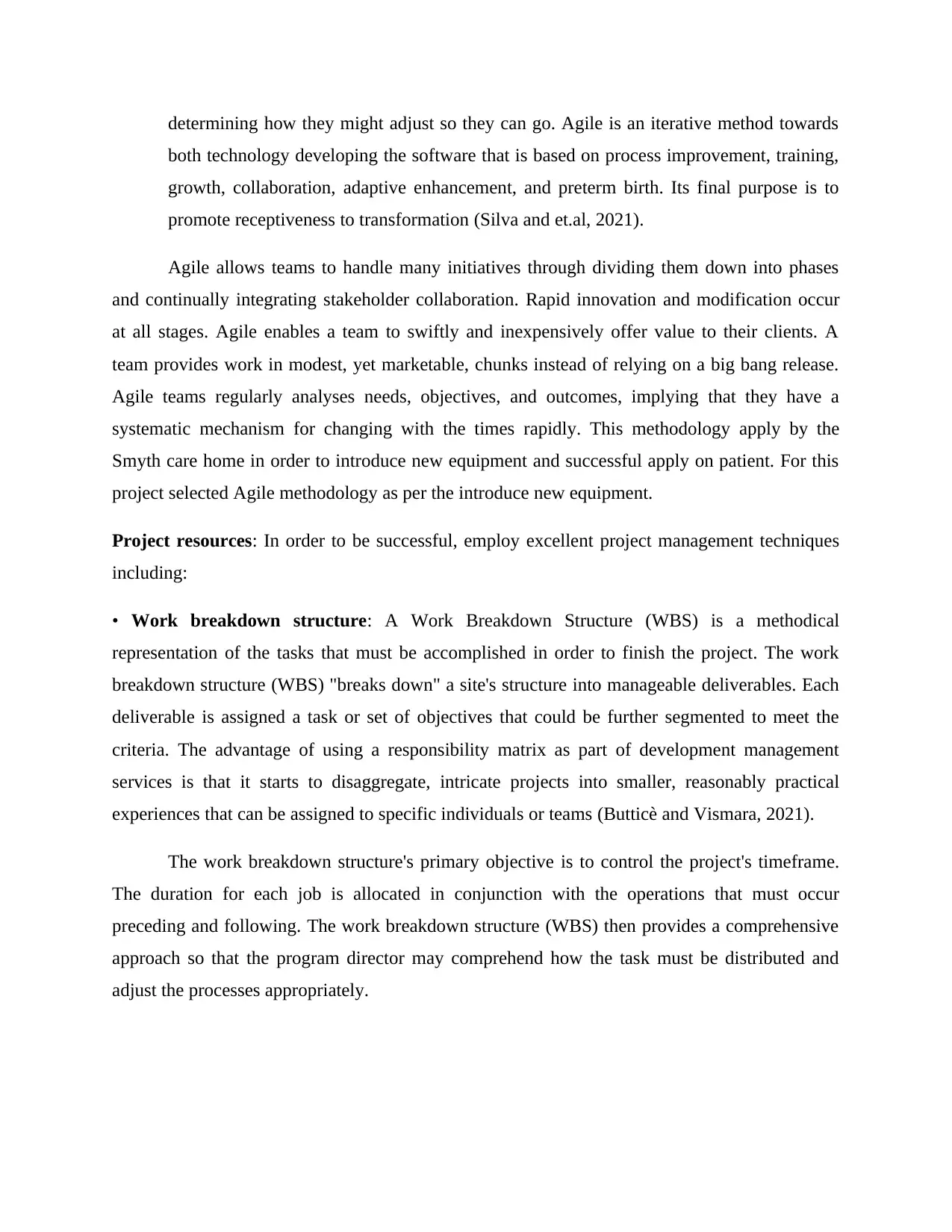
determining how they might adjust so they can go. Agile is an iterative method towards
both technology developing the software that is based on process improvement, training,
growth, collaboration, adaptive enhancement, and preterm birth. Its final purpose is to
promote receptiveness to transformation (Silva and et.al, 2021).
Agile allows teams to handle many initiatives through dividing them down into phases
and continually integrating stakeholder collaboration. Rapid innovation and modification occur
at all stages. Agile enables a team to swiftly and inexpensively offer value to their clients. A
team provides work in modest, yet marketable, chunks instead of relying on a big bang release.
Agile teams regularly analyses needs, objectives, and outcomes, implying that they have a
systematic mechanism for changing with the times rapidly. This methodology apply by the
Smyth care home in order to introduce new equipment and successful apply on patient. For this
project selected Agile methodology as per the introduce new equipment.
Project resources: In order to be successful, employ excellent project management techniques
including:
• Work breakdown structure: A Work Breakdown Structure (WBS) is a methodical
representation of the tasks that must be accomplished in order to finish the project. The work
breakdown structure (WBS) "breaks down" a site's structure into manageable deliverables. Each
deliverable is assigned a task or set of objectives that could be further segmented to meet the
criteria. The advantage of using a responsibility matrix as part of development management
services is that it starts to disaggregate, intricate projects into smaller, reasonably practical
experiences that can be assigned to specific individuals or teams (Butticè and Vismara, 2021).
The work breakdown structure's primary objective is to control the project's timeframe.
The duration for each job is allocated in conjunction with the operations that must occur
preceding and following. The work breakdown structure (WBS) then provides a comprehensive
approach so that the program director may comprehend how the task must be distributed and
adjust the processes appropriately.
both technology developing the software that is based on process improvement, training,
growth, collaboration, adaptive enhancement, and preterm birth. Its final purpose is to
promote receptiveness to transformation (Silva and et.al, 2021).
Agile allows teams to handle many initiatives through dividing them down into phases
and continually integrating stakeholder collaboration. Rapid innovation and modification occur
at all stages. Agile enables a team to swiftly and inexpensively offer value to their clients. A
team provides work in modest, yet marketable, chunks instead of relying on a big bang release.
Agile teams regularly analyses needs, objectives, and outcomes, implying that they have a
systematic mechanism for changing with the times rapidly. This methodology apply by the
Smyth care home in order to introduce new equipment and successful apply on patient. For this
project selected Agile methodology as per the introduce new equipment.
Project resources: In order to be successful, employ excellent project management techniques
including:
• Work breakdown structure: A Work Breakdown Structure (WBS) is a methodical
representation of the tasks that must be accomplished in order to finish the project. The work
breakdown structure (WBS) "breaks down" a site's structure into manageable deliverables. Each
deliverable is assigned a task or set of objectives that could be further segmented to meet the
criteria. The advantage of using a responsibility matrix as part of development management
services is that it starts to disaggregate, intricate projects into smaller, reasonably practical
experiences that can be assigned to specific individuals or teams (Butticè and Vismara, 2021).
The work breakdown structure's primary objective is to control the project's timeframe.
The duration for each job is allocated in conjunction with the operations that must occur
preceding and following. The work breakdown structure (WBS) then provides a comprehensive
approach so that the program director may comprehend how the task must be distributed and
adjust the processes appropriately.
Paraphrase This Document
Need a fresh take? Get an instant paraphrase of this document with our AI Paraphraser
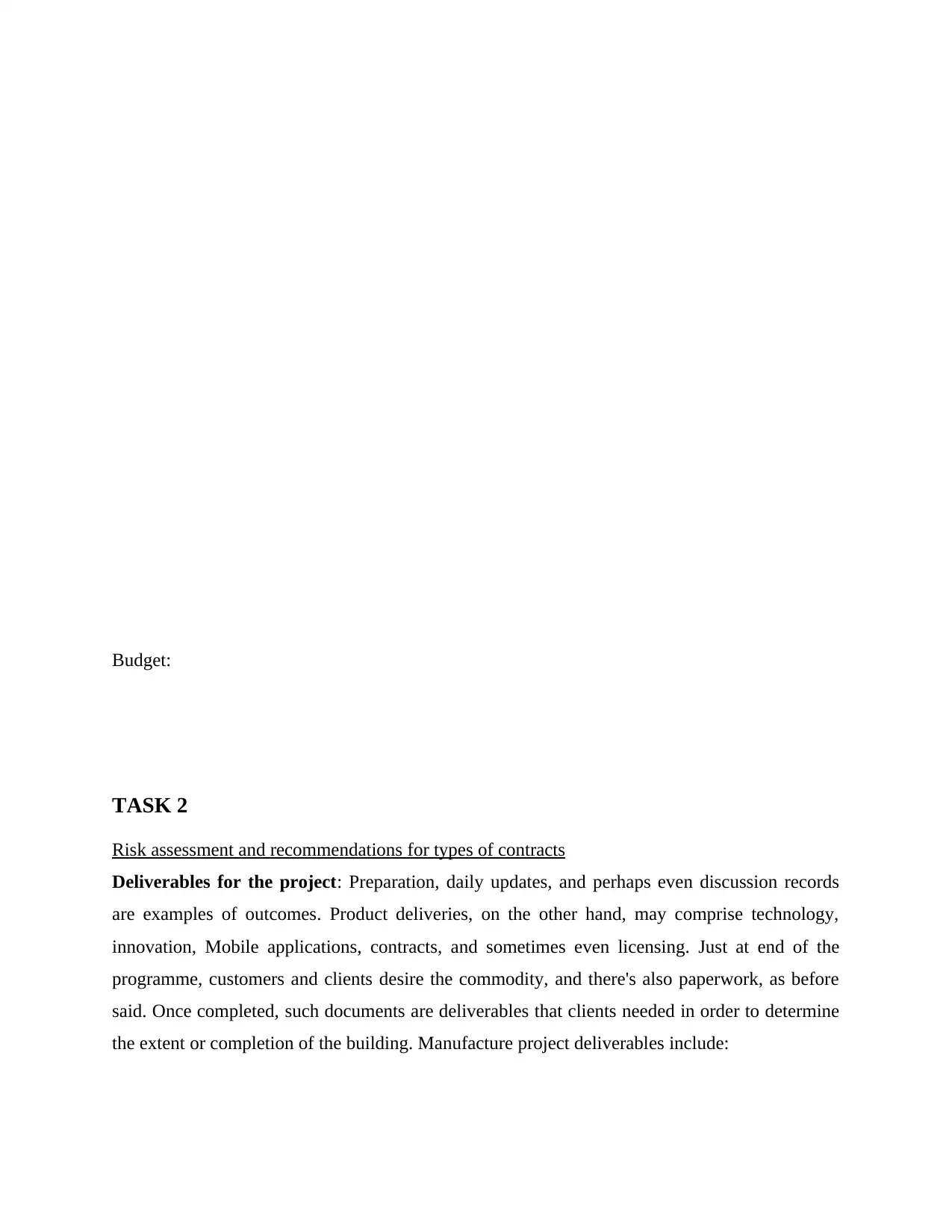
Budget:
TASK 2
Risk assessment and recommendations for types of contracts
Deliverables for the project: Preparation, daily updates, and perhaps even discussion records
are examples of outcomes. Product deliveries, on the other hand, may comprise technology,
innovation, Mobile applications, contracts, and sometimes even licensing. Just at end of the
programme, customers and clients desire the commodity, and there's also paperwork, as before
said. Once completed, such documents are deliverables that clients needed in order to determine
the extent or completion of the building. Manufacture project deliverables include:
IntroductionBackgroundcosttimescopequalityresourcesResearchmethodsDataanalysisoutliningthemesmakinggraphsinterpretingthedataconcludingfinding
TASK 2
Risk assessment and recommendations for types of contracts
Deliverables for the project: Preparation, daily updates, and perhaps even discussion records
are examples of outcomes. Product deliveries, on the other hand, may comprise technology,
innovation, Mobile applications, contracts, and sometimes even licensing. Just at end of the
programme, customers and clients desire the commodity, and there's also paperwork, as before
said. Once completed, such documents are deliverables that clients needed in order to determine
the extent or completion of the building. Manufacture project deliverables include:
IntroductionBackgroundcosttimescopequalityresourcesResearchmethodsDataanalysisoutliningthemesmakinggraphsinterpretingthedataconcludingfinding
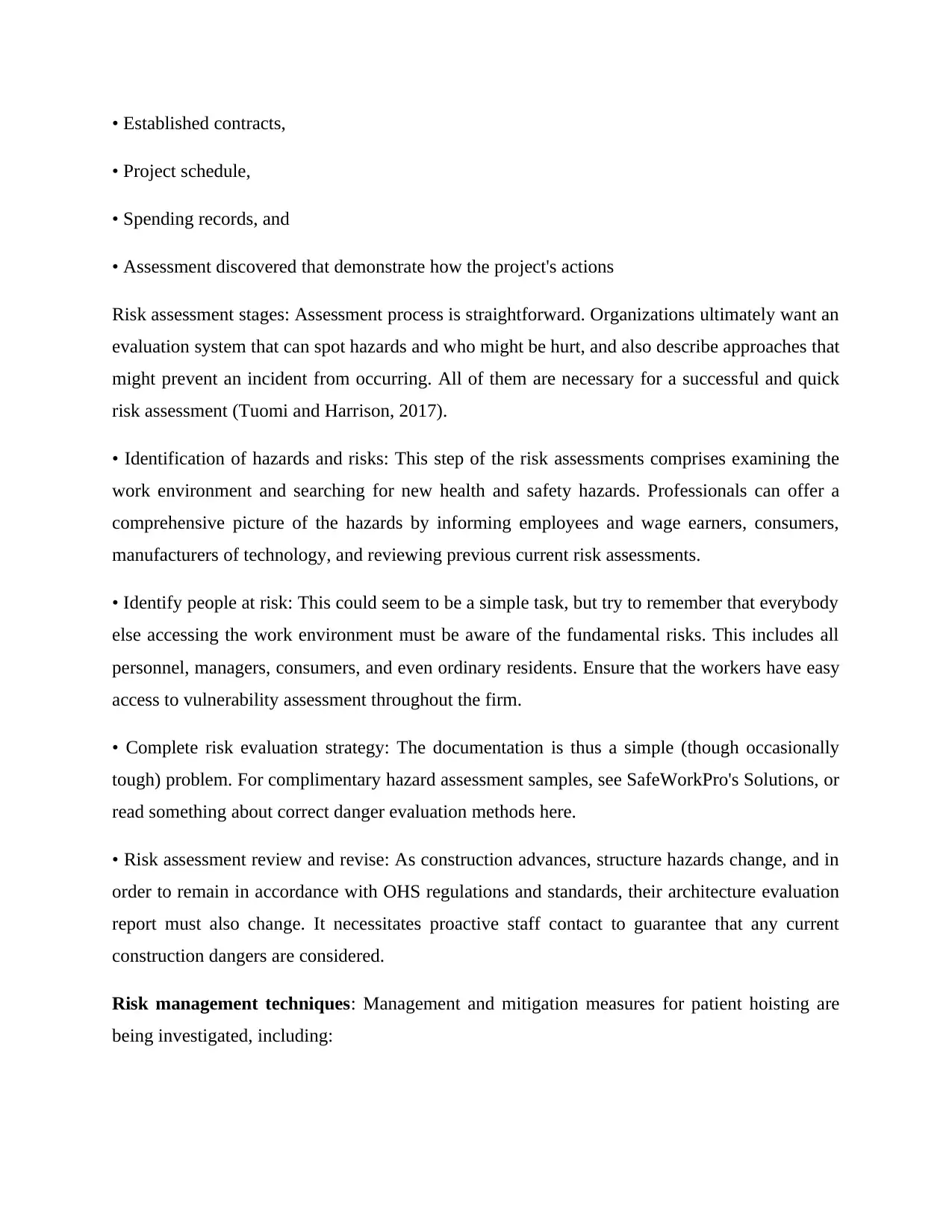
• Established contracts,
• Project schedule,
• Spending records, and
• Assessment discovered that demonstrate how the project's actions
Risk assessment stages: Assessment process is straightforward. Organizations ultimately want an
evaluation system that can spot hazards and who might be hurt, and also describe approaches that
might prevent an incident from occurring. All of them are necessary for a successful and quick
risk assessment (Tuomi and Harrison, 2017).
• Identification of hazards and risks: This step of the risk assessments comprises examining the
work environment and searching for new health and safety hazards. Professionals can offer a
comprehensive picture of the hazards by informing employees and wage earners, consumers,
manufacturers of technology, and reviewing previous current risk assessments.
• Identify people at risk: This could seem to be a simple task, but try to remember that everybody
else accessing the work environment must be aware of the fundamental risks. This includes all
personnel, managers, consumers, and even ordinary residents. Ensure that the workers have easy
access to vulnerability assessment throughout the firm.
• Complete risk evaluation strategy: The documentation is thus a simple (though occasionally
tough) problem. For complimentary hazard assessment samples, see SafeWorkPro's Solutions, or
read something about correct danger evaluation methods here.
• Risk assessment review and revise: As construction advances, structure hazards change, and in
order to remain in accordance with OHS regulations and standards, their architecture evaluation
report must also change. It necessitates proactive staff contact to guarantee that any current
construction dangers are considered.
Risk management techniques: Management and mitigation measures for patient hoisting are
being investigated, including:
• Project schedule,
• Spending records, and
• Assessment discovered that demonstrate how the project's actions
Risk assessment stages: Assessment process is straightforward. Organizations ultimately want an
evaluation system that can spot hazards and who might be hurt, and also describe approaches that
might prevent an incident from occurring. All of them are necessary for a successful and quick
risk assessment (Tuomi and Harrison, 2017).
• Identification of hazards and risks: This step of the risk assessments comprises examining the
work environment and searching for new health and safety hazards. Professionals can offer a
comprehensive picture of the hazards by informing employees and wage earners, consumers,
manufacturers of technology, and reviewing previous current risk assessments.
• Identify people at risk: This could seem to be a simple task, but try to remember that everybody
else accessing the work environment must be aware of the fundamental risks. This includes all
personnel, managers, consumers, and even ordinary residents. Ensure that the workers have easy
access to vulnerability assessment throughout the firm.
• Complete risk evaluation strategy: The documentation is thus a simple (though occasionally
tough) problem. For complimentary hazard assessment samples, see SafeWorkPro's Solutions, or
read something about correct danger evaluation methods here.
• Risk assessment review and revise: As construction advances, structure hazards change, and in
order to remain in accordance with OHS regulations and standards, their architecture evaluation
report must also change. It necessitates proactive staff contact to guarantee that any current
construction dangers are considered.
Risk management techniques: Management and mitigation measures for patient hoisting are
being investigated, including:
⊘ This is a preview!⊘
Do you want full access?
Subscribe today to unlock all pages.

Trusted by 1+ million students worldwide
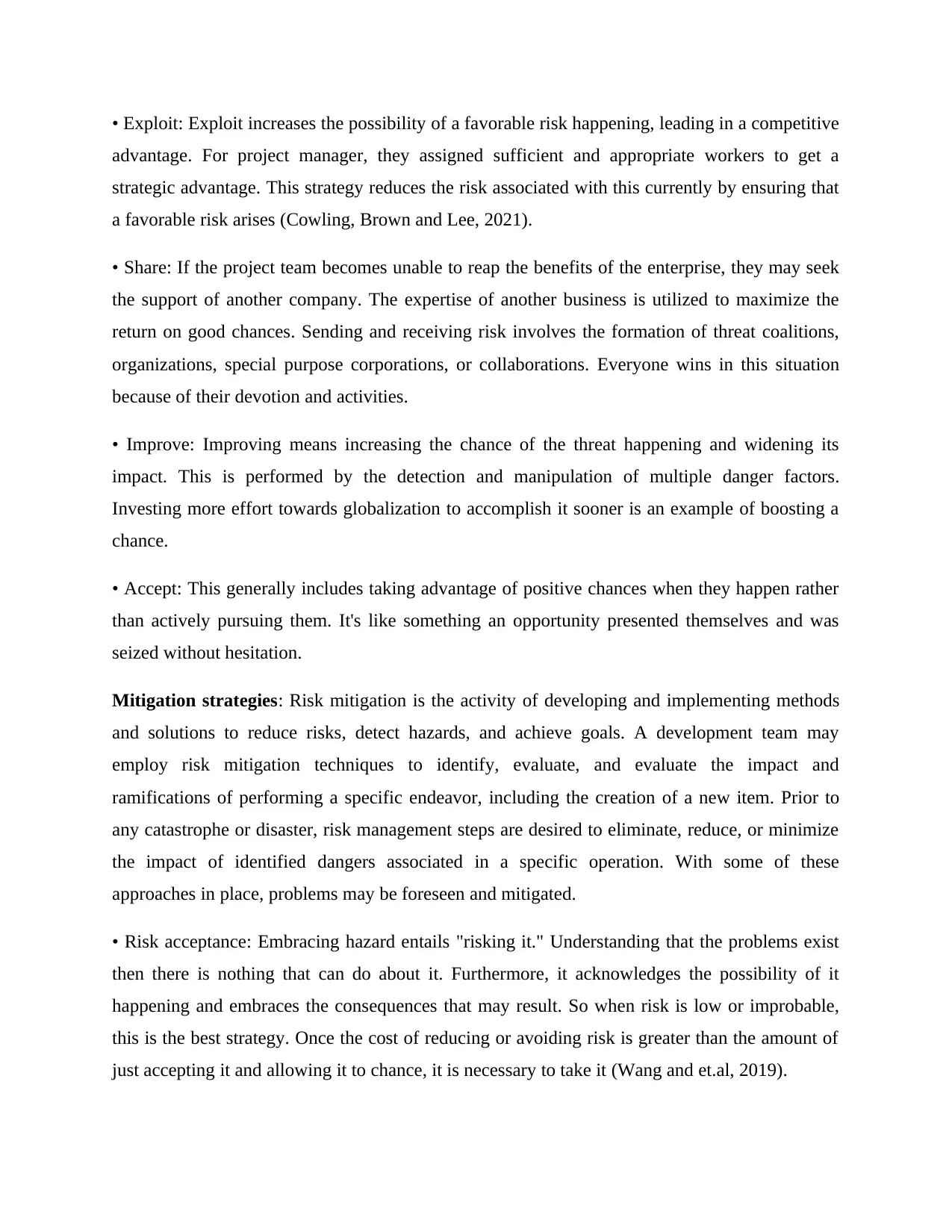
• Exploit: Exploit increases the possibility of a favorable risk happening, leading in a competitive
advantage. For project manager, they assigned sufficient and appropriate workers to get a
strategic advantage. This strategy reduces the risk associated with this currently by ensuring that
a favorable risk arises (Cowling, Brown and Lee, 2021).
• Share: If the project team becomes unable to reap the benefits of the enterprise, they may seek
the support of another company. The expertise of another business is utilized to maximize the
return on good chances. Sending and receiving risk involves the formation of threat coalitions,
organizations, special purpose corporations, or collaborations. Everyone wins in this situation
because of their devotion and activities.
• Improve: Improving means increasing the chance of the threat happening and widening its
impact. This is performed by the detection and manipulation of multiple danger factors.
Investing more effort towards globalization to accomplish it sooner is an example of boosting a
chance.
• Accept: This generally includes taking advantage of positive chances when they happen rather
than actively pursuing them. It's like something an opportunity presented themselves and was
seized without hesitation.
Mitigation strategies: Risk mitigation is the activity of developing and implementing methods
and solutions to reduce risks, detect hazards, and achieve goals. A development team may
employ risk mitigation techniques to identify, evaluate, and evaluate the impact and
ramifications of performing a specific endeavor, including the creation of a new item. Prior to
any catastrophe or disaster, risk management steps are desired to eliminate, reduce, or minimize
the impact of identified dangers associated in a specific operation. With some of these
approaches in place, problems may be foreseen and mitigated.
• Risk acceptance: Embracing hazard entails "risking it." Understanding that the problems exist
then there is nothing that can do about it. Furthermore, it acknowledges the possibility of it
happening and embraces the consequences that may result. So when risk is low or improbable,
this is the best strategy. Once the cost of reducing or avoiding risk is greater than the amount of
just accepting it and allowing it to chance, it is necessary to take it (Wang and et.al, 2019).
advantage. For project manager, they assigned sufficient and appropriate workers to get a
strategic advantage. This strategy reduces the risk associated with this currently by ensuring that
a favorable risk arises (Cowling, Brown and Lee, 2021).
• Share: If the project team becomes unable to reap the benefits of the enterprise, they may seek
the support of another company. The expertise of another business is utilized to maximize the
return on good chances. Sending and receiving risk involves the formation of threat coalitions,
organizations, special purpose corporations, or collaborations. Everyone wins in this situation
because of their devotion and activities.
• Improve: Improving means increasing the chance of the threat happening and widening its
impact. This is performed by the detection and manipulation of multiple danger factors.
Investing more effort towards globalization to accomplish it sooner is an example of boosting a
chance.
• Accept: This generally includes taking advantage of positive chances when they happen rather
than actively pursuing them. It's like something an opportunity presented themselves and was
seized without hesitation.
Mitigation strategies: Risk mitigation is the activity of developing and implementing methods
and solutions to reduce risks, detect hazards, and achieve goals. A development team may
employ risk mitigation techniques to identify, evaluate, and evaluate the impact and
ramifications of performing a specific endeavor, including the creation of a new item. Prior to
any catastrophe or disaster, risk management steps are desired to eliminate, reduce, or minimize
the impact of identified dangers associated in a specific operation. With some of these
approaches in place, problems may be foreseen and mitigated.
• Risk acceptance: Embracing hazard entails "risking it." Understanding that the problems exist
then there is nothing that can do about it. Furthermore, it acknowledges the possibility of it
happening and embraces the consequences that may result. So when risk is low or improbable,
this is the best strategy. Once the cost of reducing or avoiding risk is greater than the amount of
just accepting it and allowing it to chance, it is necessary to take it (Wang and et.al, 2019).
Paraphrase This Document
Need a fresh take? Get an instant paraphrase of this document with our AI Paraphraser
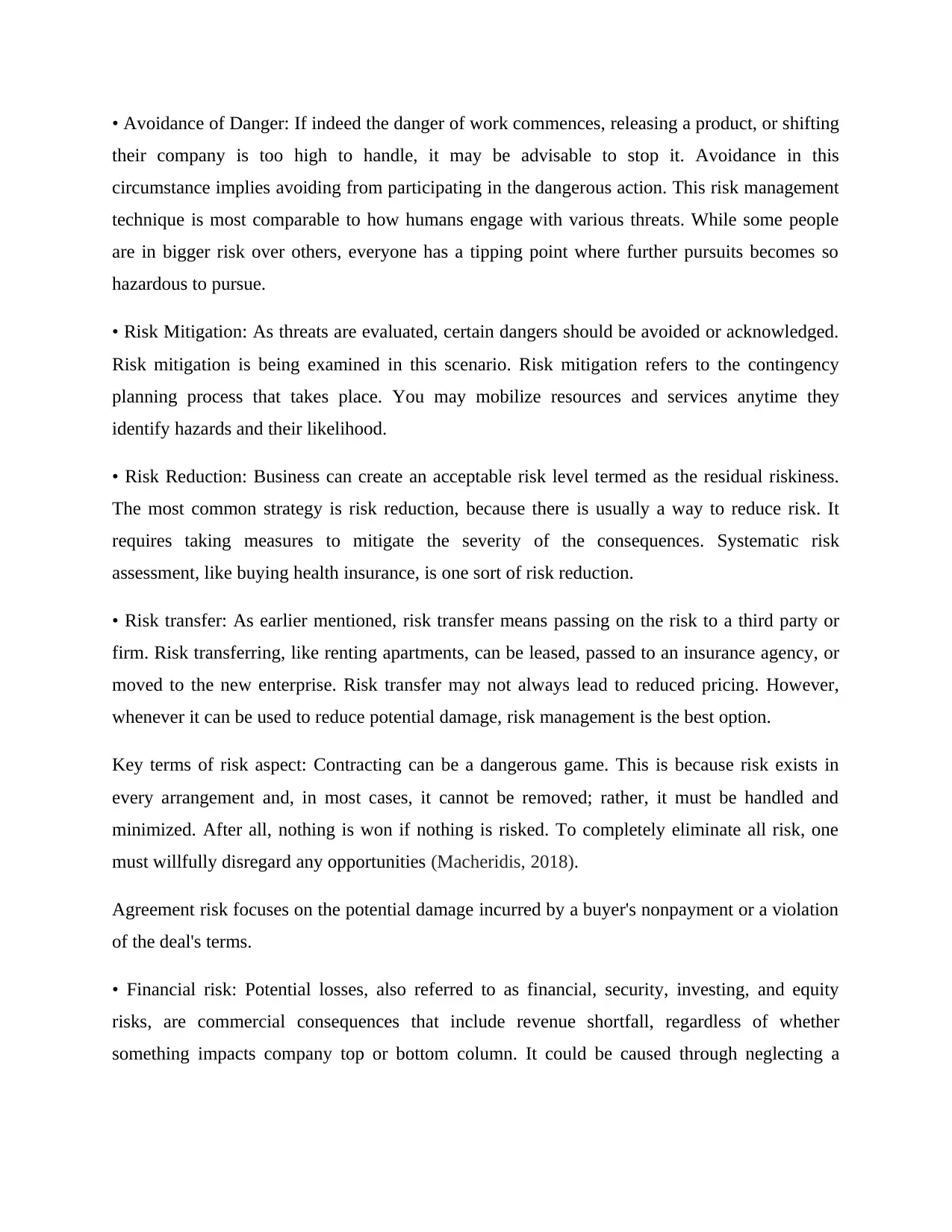
• Avoidance of Danger: If indeed the danger of work commences, releasing a product, or shifting
their company is too high to handle, it may be advisable to stop it. Avoidance in this
circumstance implies avoiding from participating in the dangerous action. This risk management
technique is most comparable to how humans engage with various threats. While some people
are in bigger risk over others, everyone has a tipping point where further pursuits becomes so
hazardous to pursue.
• Risk Mitigation: As threats are evaluated, certain dangers should be avoided or acknowledged.
Risk mitigation is being examined in this scenario. Risk mitigation refers to the contingency
planning process that takes place. You may mobilize resources and services anytime they
identify hazards and their likelihood.
• Risk Reduction: Business can create an acceptable risk level termed as the residual riskiness.
The most common strategy is risk reduction, because there is usually a way to reduce risk. It
requires taking measures to mitigate the severity of the consequences. Systematic risk
assessment, like buying health insurance, is one sort of risk reduction.
• Risk transfer: As earlier mentioned, risk transfer means passing on the risk to a third party or
firm. Risk transferring, like renting apartments, can be leased, passed to an insurance agency, or
moved to the new enterprise. Risk transfer may not always lead to reduced pricing. However,
whenever it can be used to reduce potential damage, risk management is the best option.
Key terms of risk aspect: Contracting can be a dangerous game. This is because risk exists in
every arrangement and, in most cases, it cannot be removed; rather, it must be handled and
minimized. After all, nothing is won if nothing is risked. To completely eliminate all risk, one
must willfully disregard any opportunities (Macheridis, 2018).
Agreement risk focuses on the potential damage incurred by a buyer's nonpayment or a violation
of the deal's terms.
• Financial risk: Potential losses, also referred to as financial, security, investing, and equity
risks, are commercial consequences that include revenue shortfall, regardless of whether
something impacts company top or bottom column. It could be caused through neglecting a
their company is too high to handle, it may be advisable to stop it. Avoidance in this
circumstance implies avoiding from participating in the dangerous action. This risk management
technique is most comparable to how humans engage with various threats. While some people
are in bigger risk over others, everyone has a tipping point where further pursuits becomes so
hazardous to pursue.
• Risk Mitigation: As threats are evaluated, certain dangers should be avoided or acknowledged.
Risk mitigation is being examined in this scenario. Risk mitigation refers to the contingency
planning process that takes place. You may mobilize resources and services anytime they
identify hazards and their likelihood.
• Risk Reduction: Business can create an acceptable risk level termed as the residual riskiness.
The most common strategy is risk reduction, because there is usually a way to reduce risk. It
requires taking measures to mitigate the severity of the consequences. Systematic risk
assessment, like buying health insurance, is one sort of risk reduction.
• Risk transfer: As earlier mentioned, risk transfer means passing on the risk to a third party or
firm. Risk transferring, like renting apartments, can be leased, passed to an insurance agency, or
moved to the new enterprise. Risk transfer may not always lead to reduced pricing. However,
whenever it can be used to reduce potential damage, risk management is the best option.
Key terms of risk aspect: Contracting can be a dangerous game. This is because risk exists in
every arrangement and, in most cases, it cannot be removed; rather, it must be handled and
minimized. After all, nothing is won if nothing is risked. To completely eliminate all risk, one
must willfully disregard any opportunities (Macheridis, 2018).
Agreement risk focuses on the potential damage incurred by a buyer's nonpayment or a violation
of the deal's terms.
• Financial risk: Potential losses, also referred to as financial, security, investing, and equity
risks, are commercial consequences that include revenue shortfall, regardless of whether
something impacts company top or bottom column. It could be caused through neglecting a
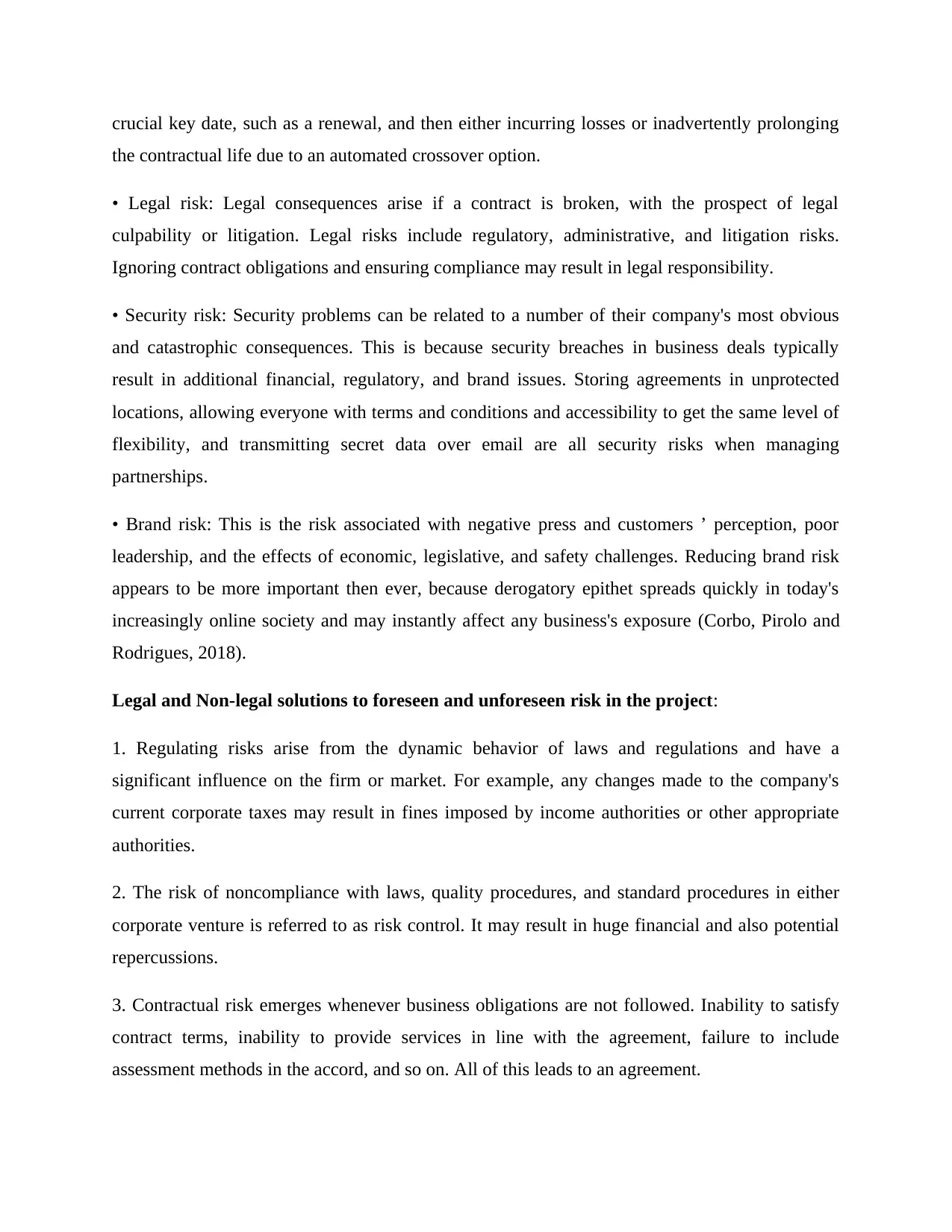
crucial key date, such as a renewal, and then either incurring losses or inadvertently prolonging
the contractual life due to an automated crossover option.
• Legal risk: Legal consequences arise if a contract is broken, with the prospect of legal
culpability or litigation. Legal risks include regulatory, administrative, and litigation risks.
Ignoring contract obligations and ensuring compliance may result in legal responsibility.
• Security risk: Security problems can be related to a number of their company's most obvious
and catastrophic consequences. This is because security breaches in business deals typically
result in additional financial, regulatory, and brand issues. Storing agreements in unprotected
locations, allowing everyone with terms and conditions and accessibility to get the same level of
flexibility, and transmitting secret data over email are all security risks when managing
partnerships.
• Brand risk: This is the risk associated with negative press and customers ’ perception, poor
leadership, and the effects of economic, legislative, and safety challenges. Reducing brand risk
appears to be more important then ever, because derogatory epithet spreads quickly in today's
increasingly online society and may instantly affect any business's exposure (Corbo, Pirolo and
Rodrigues, 2018).
Legal and Non-legal solutions to foreseen and unforeseen risk in the project:
1. Regulating risks arise from the dynamic behavior of laws and regulations and have a
significant influence on the firm or market. For example, any changes made to the company's
current corporate taxes may result in fines imposed by income authorities or other appropriate
authorities.
2. The risk of noncompliance with laws, quality procedures, and standard procedures in either
corporate venture is referred to as risk control. It may result in huge financial and also potential
repercussions.
3. Contractual risk emerges whenever business obligations are not followed. Inability to satisfy
contract terms, inability to provide services in line with the agreement, failure to include
assessment methods in the accord, and so on. All of this leads to an agreement.
the contractual life due to an automated crossover option.
• Legal risk: Legal consequences arise if a contract is broken, with the prospect of legal
culpability or litigation. Legal risks include regulatory, administrative, and litigation risks.
Ignoring contract obligations and ensuring compliance may result in legal responsibility.
• Security risk: Security problems can be related to a number of their company's most obvious
and catastrophic consequences. This is because security breaches in business deals typically
result in additional financial, regulatory, and brand issues. Storing agreements in unprotected
locations, allowing everyone with terms and conditions and accessibility to get the same level of
flexibility, and transmitting secret data over email are all security risks when managing
partnerships.
• Brand risk: This is the risk associated with negative press and customers ’ perception, poor
leadership, and the effects of economic, legislative, and safety challenges. Reducing brand risk
appears to be more important then ever, because derogatory epithet spreads quickly in today's
increasingly online society and may instantly affect any business's exposure (Corbo, Pirolo and
Rodrigues, 2018).
Legal and Non-legal solutions to foreseen and unforeseen risk in the project:
1. Regulating risks arise from the dynamic behavior of laws and regulations and have a
significant influence on the firm or market. For example, any changes made to the company's
current corporate taxes may result in fines imposed by income authorities or other appropriate
authorities.
2. The risk of noncompliance with laws, quality procedures, and standard procedures in either
corporate venture is referred to as risk control. It may result in huge financial and also potential
repercussions.
3. Contractual risk emerges whenever business obligations are not followed. Inability to satisfy
contract terms, inability to provide services in line with the agreement, failure to include
assessment methods in the accord, and so on. All of this leads to an agreement.
⊘ This is a preview!⊘
Do you want full access?
Subscribe today to unlock all pages.

Trusted by 1+ million students worldwide
1 out of 18
Related Documents
Your All-in-One AI-Powered Toolkit for Academic Success.
+13062052269
info@desklib.com
Available 24*7 on WhatsApp / Email
![[object Object]](/_next/static/media/star-bottom.7253800d.svg)
Unlock your academic potential
Copyright © 2020–2025 A2Z Services. All Rights Reserved. Developed and managed by ZUCOL.

